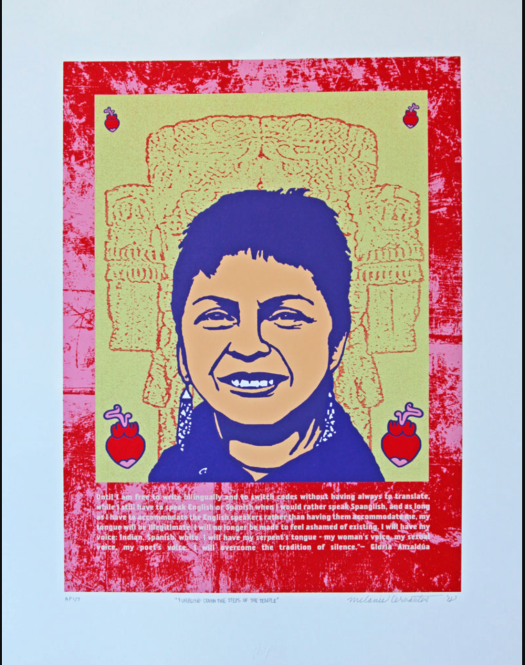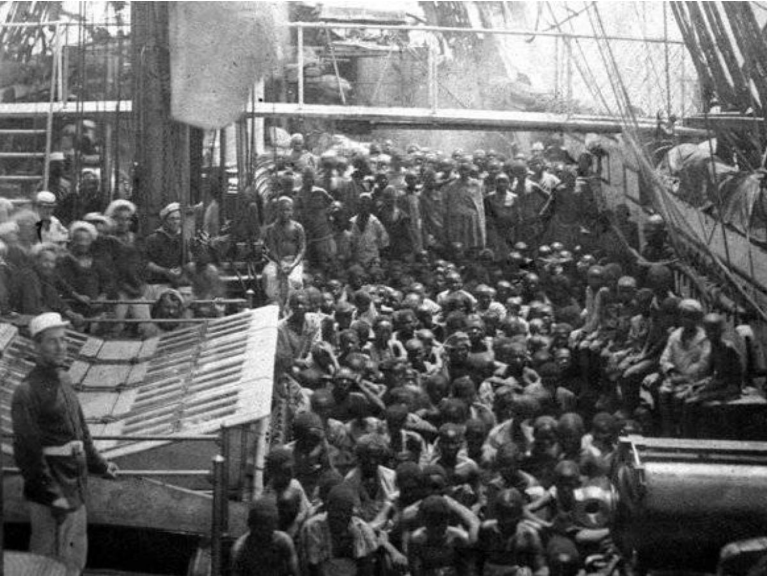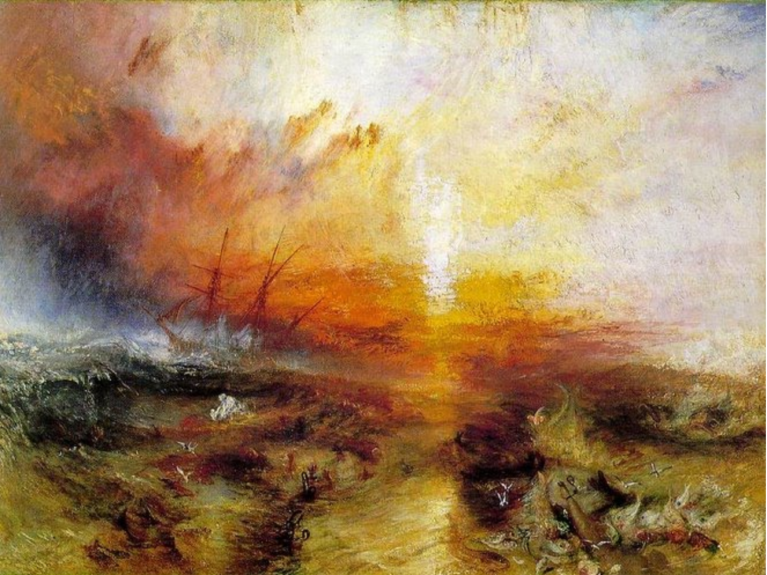Header Image: (Empoweress)
Breanna Cocuzzo
Professor Rajan
OL Intro to Lit and Cultural Studies
30 April 2018
The Crossroads of Oppression
While Frida Kahlo, Gloria Anzaldua, and Marlene NourbeSe Philip may not seem to have much in common at a first glance, their works portray many similarities in the construction of the self. Kahlo with her painting “Two Fridas”, Anzaldua with her book Borderlands, and NourbeSe Philip with her book ZONG! focus on different parts of the world however treatment of women and minorities is a common theme throughout. “Two Fridas”, Borderlands, and ZONG! portray how oppression and discrimination cause a broken sense of self within women and minorities.
Frida Kahlo’s portrays her tarnished sense of self in her paining “Two Fridas”. 
Image: (www.FridaKahlo.org)
“Two Fridas” is one of Frida Kahlo’s most famous paintings. It was painted in 1939 shortly after Frida and her husband, Diego Rivera divorced. Not only was Kahlo struggling with her identity because of the divorce, but she had been struggling with her identity because of her interior divide between cultures, modern Mexican and Indian (Tehuana). Rivera was an adamant nationalist, which caused Frida to further explore and try out the indigenism culture and traditions, including the traditional Mexican costume the Frida on the left is wearing (“Important Art by Frida Kahlo”).
 Image: (McKinney)
Image: (McKinney)
The Frida on the right in “Two Fridas” shows independent and modern Frida (“The Two Fridas, 1939 by Frida Kahlo”). She wears modern European clothing, which she wore before she married. Examining these two Fridas next to each other, it is understood that when Frida married, she began to lose her sense of self and morphed into someone more like her husband and accepted a more dependent lifestyle. However, when they divorce, she now is exposed to the fact that her sense of self is mixed up and unstable and feels as though she now has two personalities, and that is something that is troubling her. The loneliness and frustration Frida is feeling is shown through the stormy sky and “agitated clouds” (“The Two Fridas, 1939 by Frida Kahlo”).

Image: (McKinney)
The image above is from a newspaper article in the Detroit News. When they found out that Diego Rivera’s wife was also a painter, they wanted to write the article, which had demeaning hits at Frida Khahlo. The title itself acknowledges her as “Wife of the Master Mural Painter” and repeatedly calling her “Senora Rivera”, not to mention that Frida Kahlo was an artist, she didn’t just “[dabble] in works of art”. The self in “Two Fridas” is scarred by the loss of a male figure in her life with whom she was identified, the view of her as just a housewife, and the struggle in finding her cultural identity, which is a common theme in Borderlands as well.
Like Frida Kahlo, the self in Borderlands by Anzaldua struggles with identity due to being a part of multiple cultures, races, and communities. Anzaldua classifies as a Chicana. One can better understand the geographical concept of being Chicana / Chicano by the following video which explains the struggle of the Chicano community throughout history:
Video: (Smithsonian Folkways)
Borderlands for the most part is an autobiography. Anzaldua writes about the struggle she faces in being Chicana, and how her language distances her from Mexicans and Americans, leaving her without a culture. She writes about how at schools and universities, Mexican students are told to speak American, and if they do not like it they should “’go back to Mexico where they belong’” (Borderlands 75). Even when they did learn English, they were sent to speech classes to try and get rid of their accents. Meanwhile, as they learned English, Latinos and Latinas then accused them of “speaking the oppressor’s language by speaking English…ruining the Spanish language” (Borderlands 79). This gave way to the birth of Chicano Spanish, which is known as an evolving and living language.

Image: (Cervantes)
Above is an image of Anzaldua with a quote of her beneath reading,
“Until I am free to write bilingually and to switch codes without having to always translate, while I still have to speak English or Spanish when I would rather speak Spanglish, and as long as I have to accommodate the English speakers rather than having them accommodate me, my tongue will be illegitimate. I will no longer be made to feel ashamed of existing. I will have my voice: Indian, Spanish, white. I will have my serpent’s tongue – my women’s voice, my sexual voice, my poet’s voice. I will overcome the tradition of silence.”
Anzaldua has a unique voice, being a lesbian female who has characteristics of Anglo, Mexican, and indigenous cultures. She wants people to hear her voice and what she has to say. Yet she writes about how hard this is because she explains, “if you want to really hurt me, talk badly about my language. Ethnic identity is twin skin to linguistic identity – I am my language. Until I can take pride in my language, I cannot take pride in myself” (Borderlands 81). She has English speakers oppressing her into speaking good English, and Spanish speakers criticizing her Chicano Spanish by calling it “illegitimate [and] a bastard language” (Borderlands 80). All of this causes Anzaldua and the Chicano community to look at themselves differently and lower their self-esteem. On top of this, women in Chicano culture are even further criticized because they are expected to be essentially silent.

Chicanas known for “having a big mouth, questioning, and carrying tales” are seen as being bad women, “mal criada” (Borderlands 76). Anzaldua is oppressed in so many different ways because of her language that her identity and sense of self is something she starts to question.
Image: (Roberts)
Another concept Anzaldua talks about is the consciousness of the Mestiza. Mestiza is a group of people characterized by being of mixed races, ideologies and cultures and the word Mestiza translates to “torn between ways” (Borderlands 100).

Image: (Rodriguez)
Classifying as Mestiza shares common characteristics of the Chicana community because there comes an element of internal friction due to multiple personalities. Both cultures also struggle with the disagreements between the white culture, Mexican culture, and indigenous cultures, causing the Mestiza community to have to take a “counter stance” and be able to deal with contradictions (Borderlands 100). Anzaldua, being a female, a lesbian, a feminist, and Mestiza struggles with finding any type of culture that accepts her. However, Anzaldua argues that the Mestiza community is in a unique position. She writes,
“The answer to the problem between the white race and the colored, between males and females, lies in healing the split that originates in the very foundation of our lives, our culture, our languages, our thoughts. A massive uprooting of dualistic thinking in the individual and collectiveness consciousness is the beginning of a long struggle, but one that could, in our best hopes, bring us to the end of rape, of violence, of war” (Borderlands 102).
By identifying with a culture that finds itself at the crossroads of many cultures, Anzaldua believes the human race can sympathize with each other more and find the common ground of respecting each other. She explains how domestic violence and drug and alcohol abuse stem from oppression and barriers between Anglos, Chicanos, Latinos, Mexicans and Native Americans, because the men feel a lack of machismo, causing them to put down and brutalize women (Borderlands 105). This all factors into how Mestiza begin to look at themselves and causes a lot of internal conflict. This internal conflict leads to questioning of one’s identity. Anzaldua incorporates a quote into her book, “’Identity is the essential core of who we are as individuals, the conscious experience of the self inside’ – Kaufman” (Borderlands 84). This dual identity the mestiza community experiences causes them to struggle to identify with any community, and Anzaldua writes, “sometimes I feel like one cancales out the other and we are zero, nothing, no one” (Borderlands 85). This concept of having nothing to identify when one is multiethnic is also explored in the following video:
Video: (“What Are You- Mestiza”)
Feeling like some “other” entity or feeling like nothing at all negatively affects the way one looks at them self. The self in Borderlands by Anzaldua is a struggling, oppressed and confused identity, which is a theme also present in ZONG!.
ZONG! is a collection of poems by NourbeSe Philip in which the self and sense of self is wounded due to oppression, similar to the theme of Borderlands. The self in the poems is an African slave on a ship named Zong captained by Luke Collingwood. Collingwood was bringing 442 African slaves to Jamaica, when disease began to spread on board. Due to the ship being overcrowded, it spread fast and Collingwood realized he would lose money on every slave that had died, unless he threw them overboard and could claim insurance and make money back.

Image: (The Raven Report)
The poems are supposed to be from the slaves’ point of view on the ship. While the poems are on the side of abnormal, phrases such as “the some of negroes overboard”, “water rains and dead negroes”, and “this should not be” give the reader a good idea of what is going on, and listening to the poems can aid readers in understanding the intended emotion on the words of the poems (ZONG!).
Video: (BeguilingAcronym)
As seen in the painting below,
“Turner evokes the terrifying nature of the sea [during the massacre] while simultaneously shedding light on an actual historical event. The slaves’ shackles are visible, and their limbs flail out of the water in a futile attempt to wave for help. The sea seems to engulf these figures, giving them no hope for survival” (“The Slave Ship, or Slavers Overthrowing the Dead and Dying – Typhon Coming On”).

Image: (The Slave Ship)
The identities of the slaves on this ship are severely attacked as they are not even considered human, but time and time again called cargo.

Image: (Philips)
The image above portrays how an English slave ship would have been organized. Given absolutely no space and, in some cases, piled on top of each other, slaves were again reminded they were just cargo. The case landed in the hands of abolitionist Granville Sharp who brought it to Lord Mansfield. Sharp was an abolitionist who spent much of his life fighting slavery, writing pamphlets and letters (like in the image below) against the slave trade, and aiding victims of the slave trade (“A representation of the injustice and dangerous toleration of slavery, 1769, Granville Sharp).

Image: (Sharp)
Lord Mansfield stated:
“What is this claim that human people have been thrown overboard? This is a case of chattels or goods. Blacks are goods and property; it is madness to accuse these well-serving honourable men of murder…The case is the same as if wood had been thrown overboard” (“The Zong Massacre – a summary”).
This oppression and discrimination the Africans faced at the hands of the Europeans leads the self in ZONG! to be extremely impaired as they are continuously reminded that in the eyes of Europeans, they are closer related to wood than they are to human beings. They are also away stolen and brought away from their home country, taking away a sense of being a part of their own community, and in the case of the Zong ship, friends and family were drowned in front of everyone’s eyes, killing any remaining sense of community. Identity and sense of self in ZONG! is very negatively affected by the oppression by other cultures, more specifically European and white cultures.
All three works share this theme of differences in culture causing disagreements that become physically and mentally damaging. In all three works, the artist or author tried to capture these damaging effects using the self as the oppressed and struggling group. All three works successfully captured the themes of the self to find their identity, whether it was their identity within a community or their identity as a human being in general. They also successfully captured characteristics of the other, the oppressors, as being controlling, exclusive, and having traits mirroring an alpha-male personality. Moreover, one could argue that these are issues still present in society among the oppressed and the oppressors, and there is yet to be a solution for mutual respect and peace among all people.
Works Cited
Anzaldua, Gloria. “Chapter 5, 7.” Borderlands: La Frontera. Aunt Lute Books, 2012.
BeguilingAcronym. “NourbeSe Reads from Zong!” YouTube, YouTube, 22 Mar. 2010, www.youtube.com/watch?v=my4eE4denus.
Cervantes, Melanie. “Tumbling Down the Steps of the Temple.” Gloria Anzaldua. Equality Archive, 2012. http://equalityarchive.com/people/gloria-anzaldua-light-in-the-dark/
Empoweress. “All Oppression Is Connected – Mind Talk.” The Minds Journal. https://themindsjournal.com/oppression-connected-mind-talk/
“How the Slave Ship Zong Traded Sanity For Profit.” The Raven Report. 30 October 2016. https://theravenreport.com/2016/10/30/the-zong-massacre-over-a-hundred-slaves-were-thrown-overboard-on-this-damned-voyage/
“Important Art by Frida Kahlo.” The Art Story. http://www.theartstory.org/artist-kahlo-frida-artworks.htm
McKinney, Kelsey. “This 1930s article calling Frida Kahlo the ‘wife of the master mural painter’ is all wrong.” Vox. 17 March 2015. https://www.vox.com/2015/3/17/8231295/frida-kahlo-detroit
“The Zong Massacre – a summary.” History In An Hour. 29 November 2011. http://www.historyinanhour.com/2011/11/29/the-zong-massacre-a-summary/
Sharp, Granville. “A representation of the injustice and dangerous toleration of slavery, 1769.” Merseyside Maritime Museum. Liverpool Museums, Archive 512.5. http://www.liverpoolmuseums.org.uk/maritime/archive/highlights/granville-sharp-abolitionist.aspx
Roberts, J.. “The Language of Oppression.” Word Press. 23 September 2013. https://rhet101.wordpress.com/2013/09/23/the-language-of-oppression/
NourbeSe Philip, Marlene. ZONG! Wesleyan University Press, 2011.
Philips, James. “Plans and Sections of a Slave Ship.” Royal Museums Greenwich. Michael Graham Stewart Collection, Object ZBA2745, 1789. http://collections.rmg.co.uk/collections/objects/254967.html
Rodriguez, Juan. “Spaniard and Indian Produce a Mestizo.” Colonial Americas. Khan Academy. https://www.khanacademy.org/humanities/ap-art-history/early-europe-and-colonial-americas/colonial-americas/a/spaniard-and-indian-produce-a-mestizo-attributed-to-juan-rodriguez
SmithsonianFolkways. “‘Quihubo, Raza’ by Agustín Lira and Alma from Songs of Struggle & Hope.” YouTube, YouTube, 13 May 2016, www.youtube.com/watch?v=u5x_5t_ercQ&vl=en.
“The Slave Ship, or Salvers Overthrowing the Dead and Dying – Typhon Coming On.” The Slave Ship. Google Sites. https://sites.google.com/site/turnerjmw/theslaveship
“The Two Fridas, 1939 by Frida Kahlo.” www.FridaKahlo.org. 2011. https://www.fridakahlo.org/the-two-fridas.jsp
Valdez, Robert. “Si Se Puede.” Race and the Digital. USC, 9 June 2016. http://scalar.usc.edu/works/race-and-the-digital/si-se-puede-1
“What Are You? – Mestizo.” YouTube, YouTube, 24 Nov. 2015, www.youtube.com/watch?v=d0GxRz83e3o.

Excellent blog. Excellent argument supported by theorists/artists from 3 continents, excellent images and pertinent examples from popular culture. Will send you the grade in a personal email
LikeLike